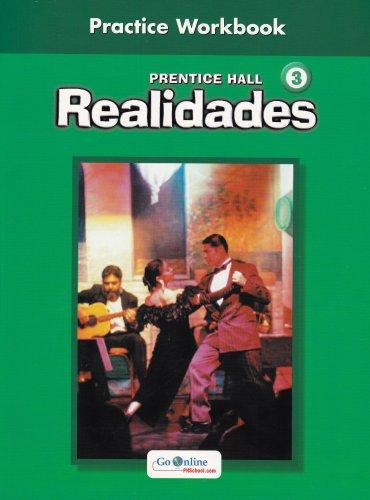
Realidades Practice Workbook 3
1st Edition
Savvas Learning Co
ISBN: 9780130360038
Textbook solutions
Chapter P: Para Empezar
Page 1: P-1
Page 2: P-2
Page 3: P-3
Page 4: P-4
Page 5: P-5
Page 6: P-6
Chapter 1: Capitulo 1
Page 7: 1-1
Page 8: 1-2
Page 9: 1-3
Page 10: 1-4
Page 11: 1-5
Page 12: 1-6
Page 13: 1-7
Page 14: 1-8
Page 15: 1-9
Page 16: 1-10
Page 17: 1-11
Page 18: 1-12
Page 19: 1-13
Page 20: 1-14
Chapter 2: Capitulo 2
Page 21: 2-1
Page 22: 2-2
Page 23: 2-3
Page 24: 2-4
Page 25: 2-5
Page 26: 2-6
Page 27: 2-7
Page 28: 2-8
Page 29: 2-9
Page 30: 2-10
Page 31: 2-11
Page 32: 2-12
Page 33: 2-13
Page 34: 2-14
Chapter 3: Capitulo 3
Page 35: 3-1
Page 36: 3-2
Page 37: 3-3
Page 38: 3-4
Page 39: 3-5
Page 40: 3-6
Page 41: 3-7
Page 42: 3-8
Page 43: 3-9
Page 44: 3-10
Page 45: 3-11
Page 46: 3-12
Page 47: 3-13
Page 48: 3-14
Chapter 4: Capitulo 4
Page 49: 4-1
Page 50: 4-2
Page 51: 4-3
Page 52: 4-4
Page 53: 4-5
Page 54: 4-6
Page 55: 4-7
Page 56: 4-8
Page 57: 4-9
Page 58: 4-10
Page 59: 4-11
Page 60: 4-12
Page 61: 4-13
Page 62: 4-14
Chapter 5: Capitulo 5
Page 63: 5-1
Page 64: 5-2
Page 65: 5-3
Page 66: 5-4
Page 67: 5-5
Page 68: 5-6
Page 69: 5-7
Page 70: 5-8
Page 71: 5-9
Page 72: 5-10
Page 73: 5-11
Page 74: 5-12
Page 75: 5-13
Page 76: 5-14
Chapter 6: Capitulo 6
Page 77: 6-1
Page 78: 6-2
Page 79: 6-3
Page 80: 6-4
Page 81: 6-5
Page 82: 6-6
Page 83: 6-7
Page 84: 6-8
Page 85: 6-9
Page 86: 6-10
Page 87: 6-11
Page 88: 6-12
Page 89: 6-13
Page 90: 6-14
Chapter 7: Capitulo 7
Page 91: 7-1
Page 92: 7-2
Page 93: 7-3
Page 94: 7-4
Page 95: 7-5
Page 96: 7-6
Page 97: 7-7
Page 98: 7-8
Page 99: 7-9
Page 100: 7-10
Page 101: 7-11
Page 102: 7-12
Page 103: 7-13
Page 104: 7-14
Chapter 8: Capitulo 8
Page 105: 8-1
Page 106: 8-2
Page 107: 8-3
Page 108: 8-4
Page 109: 8-5
Page 110: 8-6
Page 111: 8-7
Page 112: 8-8
Page 113: 8-9
Page 114: 8-10
Page 115: 8-11
Page 116: 8-12
Page 117: 8-13
Page 118: 8-14
Chapter 9: Capitulo 9
Page 119: 9-1
Page 120: 9-2
Page 121: 9-3
Page 122: 9-4
Page 123: 9-5
Page 124: 9-6
Page 125: 9-7
Page 126: 9-8
Page 127: 9-9
Page 128: 9-10
Page 129: 9-11
Page 130: 9-12
Page 131: 9-13
Page 132: 9-14
Chapter 10: Capitulo 10
Page 133: 10-1
Page 134: 10-2
Page 135: 10-3
Page 136: 10-4
Page 137: 10-5
Page 138: 10-6
Page 139: 10-7
Page 140: 10-8
Page 141: 10-9
Page 142: 10-10
Page 143: 10-11
Page 144: 10-12
Page 145: 10-13
Page 146: 10-14
All Solutions
Page 132: 9-14
Exercise 1
Step 1
1 of 1
En cuanto
Mientras
Hasta que
Cuando
Después de que
Tan pronto como
Mientras
Hasta que
Cuando
Después de que
Tan pronto como
As soon as
While
until
When
After what
As soon as
While
until
When
After what
As soon as
Exercise 2
Step 1
1 of 1
The subjunctive is used after these conjunctions when the action that follows has not yet taken place.
Exercise 3
Step 1
1 of 1
The subjunctive mood:
Antes de que + subjunctive.
Antes de que + tú vengas. / Before you come.
Exercise 4
Step 1
1 of 1
A menos que
Aunque
Sin que
Para que
Aunque
Sin que
Para que
Unless
Even if
Without
So that
Even if
Without
So that
Exercise 5
Step 1
1 of 1
If the subject of the sentence does not change, we use the infinitive after para and sin:
Debemos tomar conciencia para evitar la destrucción del medio ambiente./ We must become aware to avoid the destruction of the environment.
Exercise 6
Step 1
1 of 1
With the conjunction aunque, we use the subjunctive to express uncertainty:
Aunque tú me veas, no podrás hacer nada./ Even if you see me, you won’t be able to do anything.
Exercise 7
Step 1
1 of 1
With the conjunction aunque, we use the indicative when there is no uncertainty:
No quiere escuchar ese disco aunque todos dicen que es el mejor de todos los tiempos./ He doesn’t want to hear that record even though everyone says it’s the best of all time.
Exercise 8
Step 1
1 of 1
We use the relative pronoun que to refer to things.
El disco que te regalé./ The album that I gave you.
Exercise 9
Step 1
1 of 1
We use quien(es) to refer to people. Que is used to referring to things.
La persona de quien te hablé hace ejercicio./ The person I told you about exercises.
Exercise 10
Step 1
1 of 1
We use lo que to refer to a situation, action, object or concept.
Te digo lo que me dijeron./ I tell you what they told me.
Haven't found what you were looking for?
Search for samples, answers to your questions and flashcards

unlock
